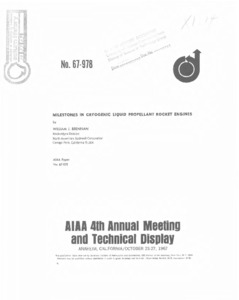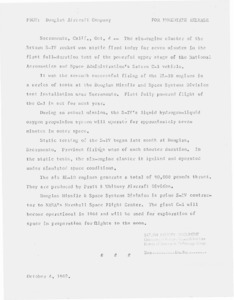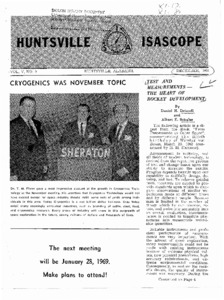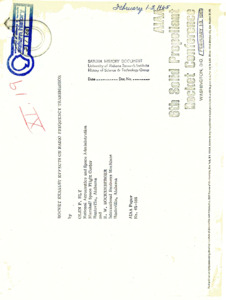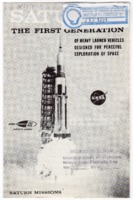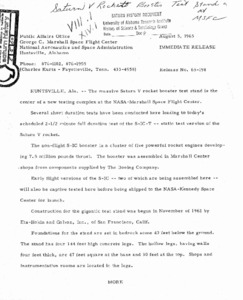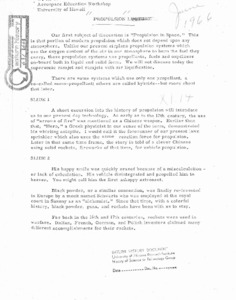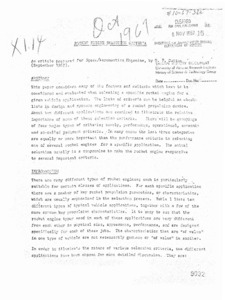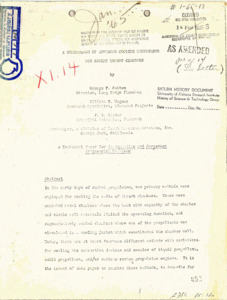
Browse Items (11 total)
Sort by:
-
"Milestones in cryogenic liquid propellant rocket engines."
This paper reviews the milestones achieved with cryogenic liquid propellant rocket engines, discusses current technology improvement programs, and projects future engine designs. During the last two decades, these cryogenic rocket engines have played a major role in rocketry and achieved numerous important milestones. These engines power the Vanguard, Redstone, Thor, Atlas, and Titan I vehicles , the Saturn I and Uprated Saturn I vehicles, and will soon be employed in the Saturn V for the Apollo missions. The requirements dictated by these vehicles have necessitated growth from the 27,000-pound-thrust Vanguard engine to the 7,600,000-pound-thrust booster cluster for the Saturn V. Gains in specific impulse have also been significant. The successful application of liquid hydrogen in the Centaur and Saturn upper-stage rocket engines was a major achievement. -
"Six-engine cluster of the Saturn S-IV rocket."
A press-release detailing the successfuly firing and the specfic launching information of the Saturn I-V rocket-launch. -
Huntsville Isascope: Volume V, No. 9.
The following article is a digest from the Book, "From Peenemunde to Outer Space", commemorating the fiftieth birthday of Wernher von Braun, March 23, 1962 condensed by H. M. Hammac). -
"Rocket exhaust effects on radio frequency transmission."
Presented by Olen P. Ely, National Aeronautics and Space Administration, Marshall Space Flight Center, Huntsville, Alabama and R. W. Hockenberger, International Business Machines. Paper that explores the effects of rocket-engine exhaust on radio-signals. -
"Saturn I: The First Generation of Heavy Launch Vehicles Designed for Peaceful Exploration of Space."
The leaflet outlines the history of Saturn launches and gives a physical description of the rocket. The description includes a diagram of each stage; specifications of each stage's thrust, propellants, liftoff weight, and burning time; and engine specifications. -
"Ground testing at MSFC : research achievements review series no 9"
In 1955, the team which has become the Marshall Space Flight Center (MSFC) began to organize a research program within its various laboratories and offices. The purpose of the program was two-fold: first, to support existing development projects by research studies and second, to prepare future development projects by advancing the state of the art of rockets and space flight. Funding for this program came from the Army, Air Force, and Advanced Research Projects Agency. The effort during the first year was modest and involved relatively few tasks. The communication of results was, therefore, comparatively easy.; Pages of handwritten notes on yellow legal paper. There is also a 3 x 5 inch card with this information. Article reference for Saturn History Files: Schuler, Albert E. (NASA-MSFC) Research and development in instrumentation for static testing. -
"Saturn V rocket booster test stand at MSFC."
Press release.; Release No. 65-198. -
"Propulsion lecture."
Lecture discussing the types of propellant used in space rockets. -
"Rocket engine selection criteria."
This paper considers many of the factors and criteria which have to be considered and evaluated when selecting a specific rocket engine for a given vehicle application. The lists of criteria can be helpful as checklists in design and systems engineering of a rocket propulsion device. About ten different applications are examined to illustrate the relative importance of some of these selection criteria. There will be groupings of our major types of criteria; namely, performance, operational, economic and so-called judgment criteria. In many cases the last three categories are equally or more important than the performance criteria in selecting one of several rocket engines for a specific application. The actual selection usually is a compromise to make the rocket engine responsive to several important criteria. -
"A Comparison of Advanced Cooling Techniques for Rocket Thrust Chambers".
The document is a technical paper for Astronautics and Aerospace Engineering Magazine.The copy has handwritten notes that appear to be for revisions. The abstract states "In the early days of rocket propulsion, two primary methods were employed for cooling the walls of thrust chambers. These were uncooled metal chambers where the heat sink capacity of the chamber and nozzle wall materials limited the operating duration, and regeneratively cooled chambers where one of the propellants was circulated in a cooling jacket which constituted the chamber wall. Today, there are at least fourteen different methods with variations for cooling the combustion devices and nozzles of liquid propellant, solid propellant, and/or nuclear rocket propulsion engines. It is the intent of this paper to examine these methods, to describe for each the useful range of operating conditions, as well as present and likely future applications, to define their limitations and associated problems. Emphasis is primarily placed on liquid rocket engines."
